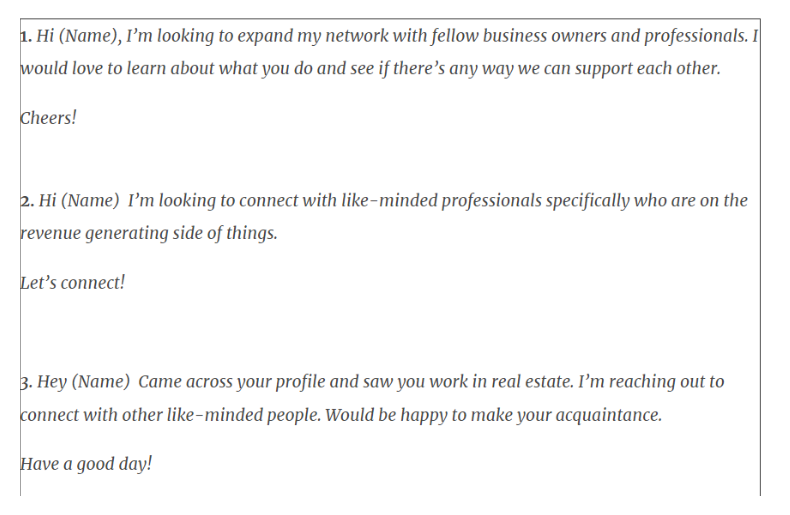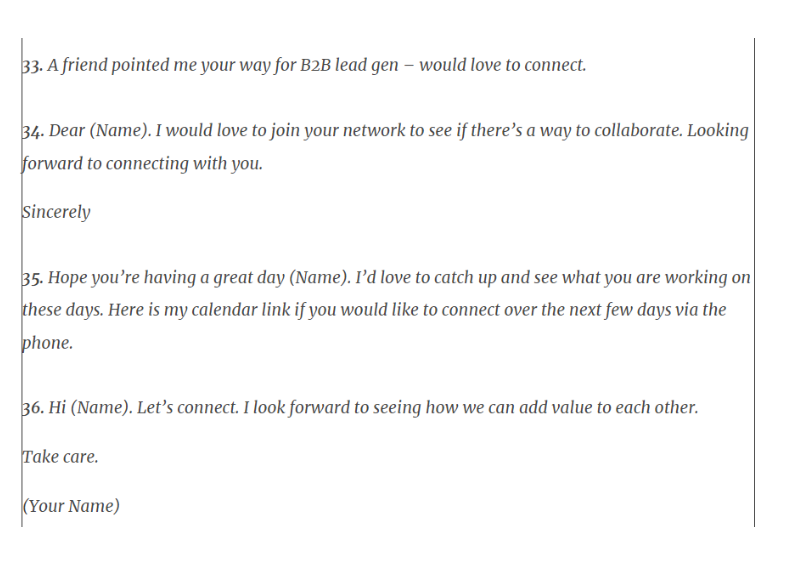If someone told you, you had to get a 100% Linkedin response rate, or else…
What strategy would you use for your outreach campaign?
The stakes are as follows:
There are basically 10 third-degree connections on Linkedin, of marketing directors (you can apply this strategy to pretty much any industry) in North America.
What would you do to get a reply?
The reply could be anything, but you have to get 10 replies….
Here’s what we would do and what you could do to get a better response rate:
(Just remember, some of these ideas are pretty creative and are designed to help you think outside the box. If you would like a traditional strategy that guarantees leads, read this:
Why We Set Out To Build The Best Done-For-You Lead Generation Service
It shares our strategy for getting 1 lead a day. These strategies can apply to cold email, as well as cold calling. Read this for more info on different strategies for different forms of outreach.)
Find someone in your network who knows the prospect
Whether it’s their boss, their friend, or a family member.
Why?
Because if you can strike up a conversation with someone who the prospect knows, you will be able to figure out what it would take to get them to reply to you.
If a person is already in your network on Linkedin, they will be much more likely to engage with you.
They could even refer you to the prospect by means of an intro.
So find 20 people who know your prospect really well. Whether it’s co-workers, previous co-workers, current boss, co-founder, etc.
Then you would have to figure out a very good reason why they would want to set up a conference call together.
Example:
“Hey. I know XYZ is hiring a designer. I can’t get through to him. I know he’s really busy, but I have two great designers right now that used to work for Forbes. They are currently looking for a job and I know that this is right up their alley.
Could you do me a favor and set up a quick call with all of us together, since we are already connected?”
See the screenshot example below:

Because I have a mutual connection who is on the hiring team, I would reach out to him to set up a meeting with the principal hiring consultant on the team.
It’s much easier to get a reply from your ideal prospect or target when there is someone already in your network who could give you an introduction.
Research the prospect to figure out what they really want
If you spend some time researching your 10 prospects, you will be able to figure out what they really want.
For example, by checking out their social media pages, you might conclude that they really need a “done-for-you” lead generation service; or they really need designers (like the above example.)
Or maybe have a look at their Linkedin posts/Linkedin profiles. If you notice that founders are ranting about finding good content marketers and your business offers the service, reach out to them.
If you solve their pain points, you will get a higher response rate. Reach out to people who need what you’re selling right now.
You could also use tools like Zoominfo, which can help you find buyer intent data.
If you use tools like this, it can help you find sales-ready prospects who need what you’re selling.

(Side note: It’s an incredibly expensive tool. We know someone who is spending like $ 40k a year on it. But if you’re willing to spend the cash, it might be worth it for your business.)
Offer prospects something of value in return for your “ask”
When wanting a guaranteed reply, you could always offer the prospect something in return for an intro, a booked sales call, or even a referral.
For example, if they are willing to give you an intro to someone you would like to talk to, you could reciprocate the offer. Perhaps there is someone valuable in your network that they would like to reach out to.
Free gifts also work well. You could offer a free sample of something your company does, for example, employee appreciation gifts, or an Amazon gift card.
People often feel indebted when they are offered something of value.
Use personalization when sending Linkedin messages
Whether you’re sending a connection request or a Linkedin InMail message, you have to use personalization.
Stats show that personalized messages have a 15% better response rate than bulk messages.
So if you want a high response rate you have to send a personalized message. As we mentioned above, you will need to do some research first and use the CCQ method.
CCQ means:
- Compliment
- Commonalities
- Questions
When looking at a Linkedin user‘s profile, or when you Google their name, try to find something to either compliment them on, a shared commonality to mention, or a question to ask them.
You will notice we used this approach in the templates shared below:



Use a clear call to action with a “low commitment ask”
A call to action tells the prospect exactly what you need from them. Whether you want them to hop on a quick sales call, or visit your website, mention this in your CTA.
The most important thing about a CTA is to make it as easy as possible for the prospect to say yes. If you use a “high commitment” ask, you are going to get a low response rate.
High commitments “asks” include things like:
- Please watch my 3-hour webinar
- Let’s hop on a 60-minute sales call on (day) (time)
- Would you be interested in reading my content and offering advice?
The above CTAs are a surefire way to make prospects run for the hills. People don’t have the time.
So make it easy.
Use the following CTAs:
- Can we hop on a 10-minute quick call when it suits you?
- Reply yes if you would like more info
- I can arrange with your personal assistant if that helps
- Interested in a quick chat?
- When are you free this week? Here is a link to my calendar.
Side note on using InMail and Linkedin InMail response rates
At SalesBread we prefer using connection requests because we have found that they have a better reply rate.
Remember, if you’re using InMail you’re most probably reaching out to someone in your third-degree network.
Stats show that the average Linkedin InMail response rate is between 18%-25%, whereas with Linkedin direct messages we are seeing a 45% acceptance rate and a 39% positive reply rate.
We prefer to reach out to second-degree connections because you already have a mutual connection.
This means that the prospect will most probably be more willing to reply to you because you already have something in common.
InMails are also a paid-for service, (you only receive a certain amount of InMail credits) so prospects might be picky about who they respond to.
We have found that InMail response rates can be lower compared to sending a connection request and sending a follow-up.
If you want a guaranteed reply using InMail, you are going to have to write a killer message with a no-brainer value add.
This will ensure that they reply.
Here are some Linkedin InMail tips
- Use a short catchy subject line
- Write a short Inmail. Remember people don’t have time, be short and to the point.
- Use personalization
- Add something of value to your Inmail that the user won’t be able to resist; this means that you have to research the prospect to find out what they really want.
- Have a clear CTA – whether it’s directing a prospect to your website, or hopping on a quick call.
Want to work with a lead gen agency where you can expect a lead a day?
Let’s talk.
Try out the above methods and if you can get even 6 people to reply out of 10, you have a great indication that these tactics work.
And if you’re interested in scaling your lead generation efforts, let’s hop on a free 15-minute strategy call. We would love to help you find qualified sales leads.
